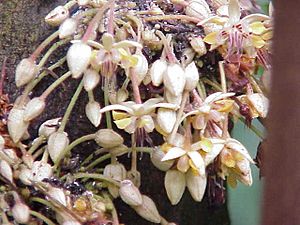Forcipomyia squamipennis facts for kids
Quick facts for kids Forcipomyia squamipennis |
|
|---|---|
| Scientific classification | |
| Genus: |
Forcipomyia
|
| Species: |
squamipennis
|
Forcipomyia squamipennis is a tiny biting midge, a type of small fly. It belongs to the Forcipomyia group. This midge is super important because it helps pollinate cacao trees in Ghana. Cacao trees are where we get chocolate from! Other similar midges help pollinate these trees in different warm, tropical places around the world.
Life Cycle of the Cacao Midge
Forcipomyia squamipennis is a very important helper for the cacao tree in Ghana. It helps the tree make new seeds, which grow into new trees. It's not that each midge is super good at pollinating. It's because there are so many of them in cacao farms!
These midges are most common during the rainy season. Adult midges like to hide during the day. They find shady spots, like between big tree roots or in cracks in logs. They also hide in hollow tree stumps or piles of old plant bits.
They come out at different times of the day. They often fly together in groups near their hiding spots. In the late afternoon and early morning, they spread out. Most midges don't fly very far, usually only about 6 meters (20 feet).
Female midges lay their eggs on damp piles of plant waste. They can lay up to about ninety eggs at one time. The eggs hatch after only two or three days. The tiny larvae then grow through four stages. They become pupae after about twelve days.
The adult midges live for about a week. Scientists think there are about twelve new groups of midges born each year. Both male and female midges eat the pollen from cacao flowers. However, four times more male midges visit the flowers than females.
How Midges Help Cacao Trees
Midges from the family Ceratopogonidae are thought to be the most important pollinators of cacao trees worldwide. This is especially true for the slightly larger midges in this family. Cacao trees grow many flowers, but only a few of them actually turn into cacao pods. This is especially true during the dry season. If the tree doesn't get enough water, all its flowers can drop off in about five days.
For a cacao flower to be successfully pollinated, it needs at least 35 good pollen grains. The time of year also affects how well pollination works.


